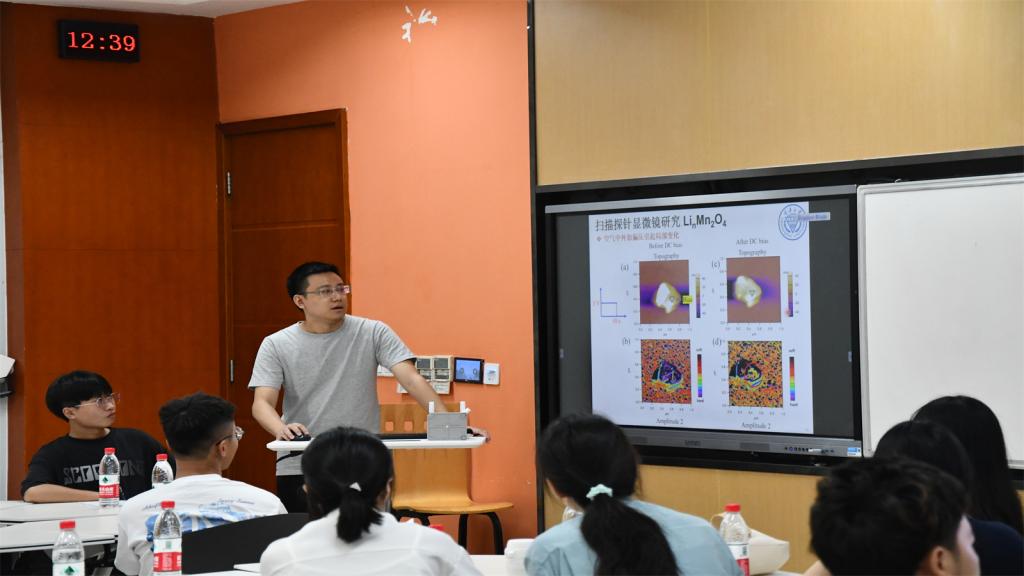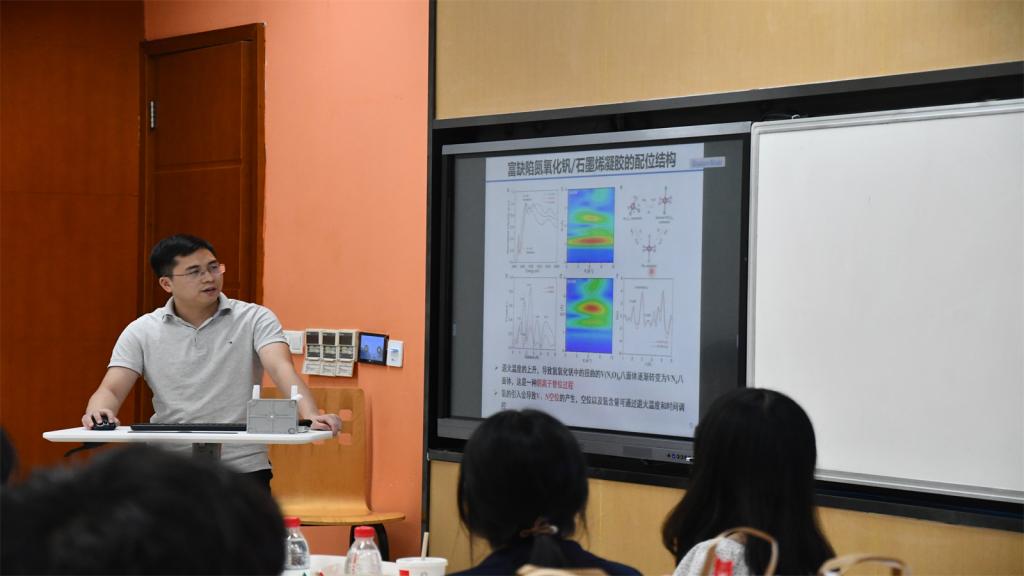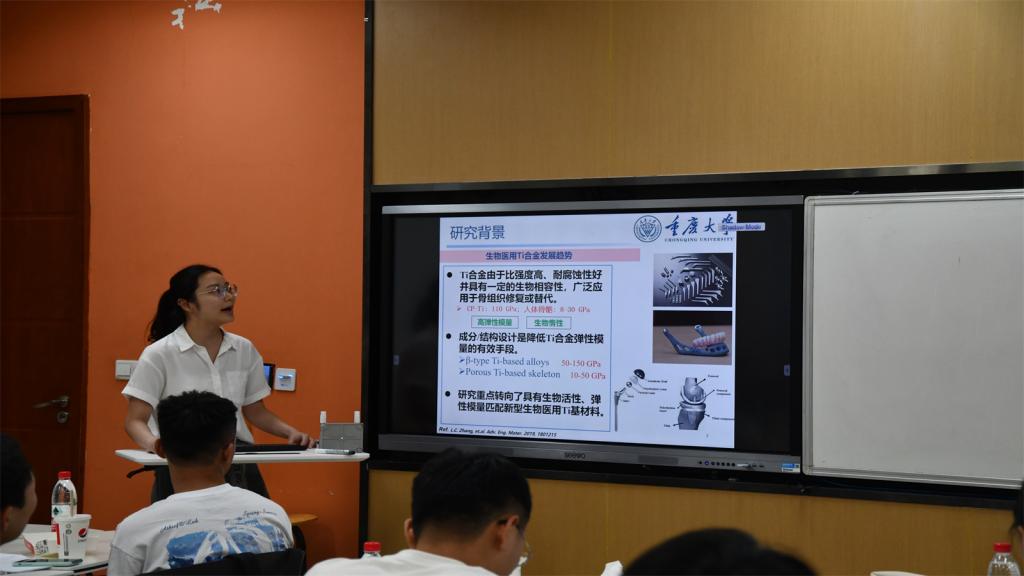In order to carry forward the academic spirit, activate academic thoughts, and provide a good academic environment and research atmosphere for the growth of young teachers and doctors, the College of Materials Science and Engineering held the ninth Youth Academic Salon on September 23, 2021. Hongshen young teachers Zhongting Wang, Shuangshuang Tan and Sihui Ouyang were invited to attend the academic conference on the theme of Simulation and Computation in Materials Research. This time, the academic exchange activities were held in the form of an academic salon. The purpose is to allow teachers and students to conduct academic exchanges in a relaxed and happy atmosphere. We hope everyone will participate in the interaction actively.
First, young reseacher Zhongting Wang shared the topic of "Research on Rechargeable Battery Materials by Probe Microscopy and Molecular Dynamics". He introduced that lithium batteries have the characteristics of high energy density, long cycle life, no memory effect, and flexible design. Mr. Wang has studied battery materials at different scales, including full-cell scale, interface scale, grain scale and atomic scale. Mr. Wang pointed out that the properties of materials at the nanoscale affect the performance of the entire battery, such as microcrack propagation, ion movement paths, and so on. Then, Mr. Wang gave a detailed analysis of the scanning probe microscope, which gave us a new understanding of the probe microscope. At the same time, Mr. Wang also introduced the process of quantitative molecular dynamics research on LinCoO2, and gave the stress-strain curve calculated by molecular dynamics. And he compared the difference between Young's modulus and lithium ion concentration during uniaxial tension and uniaxial compression. Finally, Mr. Wang gave a detailed analysis and introduction to the process and conclusion of the scanning probe microscopy and molecular dynamics research on LinMn2O4. It has greatly broadened the students' vision of battery materials, and aroused great interest and in-depth thinking of teachers and students.

Then, Shuangshuang Tan shared with us " Design of Solid Sulfur Catalyst Support and Control of Anode Interface for Lithium-sulfur Batteries". First of all, Shuangshuang Tan started with that Lithium-sulfur batteries have the highest energy density among metal chalcogenide batteries, and briefly introduced its advantages, challenges and past research progress, so that everyone can have a preliminary understanding of this topic. Then, from the aspects of preparation, structure, performance and mechanism, the defect-rich vanadium oxynitride/graphene gel sulfur-fixing catalyst, binary metal nitride heterojunction/graphene sulfur-fixing matrix, modified layer of ultra-long lithium fluoride nanofiber separator were introduced in detail. He explained that the performance of this kind of battery can greatly surpass that of commercial lithium-ion batteries, showing great development prospects. During this period, he also took the new Tesla energy vehicle battery on fire that happened in our lives as an example to illustrate the importance and difficulty of ensuring the safety of batteries in the process of commercialization. Finally, he prospected the subject from the improvement of the battery cathode and anode materials, and then the assembly of the full battery, and finally the commercialization.

Finally, Dr. Sihui Ouyang reported on "Research on Bone Tissue Repair and Regeneration Guided by Biomedical Ti-Mg Composites". Dr. Sihui Ouyang first introduced the basic knowledge of biomedical Ti alloys and biomedical Mg alloys. Based on this, she led to a new idea of material (structure) design to obtain biomedical Ti-Mg composite materials, and explained the advantages of this material in lower modulus and rapid osteogenesis. Secondly, Dr. Sihui Ouyang pointed out that the research topic was based on the method of powder metallurgy, and the good interface bonding of titanium and magnesium was realized by controlling the spark plasma sintering process. And this research had proved the relationship between microstructure-mechanical properties-biological properties, which had laid a theoretical foundation and provided design ideas for the development and application of biomedical metal matrix composites. Thirdly, after obtaining the samples at the optimum temperature, various properties of the material were analyzed, including mechanical properties, degradation behavior and biological evaluation. Among them, the relationship between the in vivo (in vitro) degradation behavior and osteogenic properties of titanium-magnesium composites was explored systematically by the material biological evaluation. And the antibacterial properties in the biological evaluation of materials were introduced, including pointing out that the experiment was carried out on rats, the antibacterial principle of the materials and the specific process of the experiment.

During the academic exchange meeting, the lecturers interacted with the teachers and students on site for many times. Teachers and students from different fields expressed different views and opinions on the same issue. The atmosphere was very active and the salon ended with warm applause.
Through this youth salon activity, young teachers and students had a deeper understanding of "Simulation and Computation in Material Research". In the future, the college will continue to carry out youth academic salon activities, constantly explore the role of scientific research in cultivating students, and promote the development of scientific research of the College.